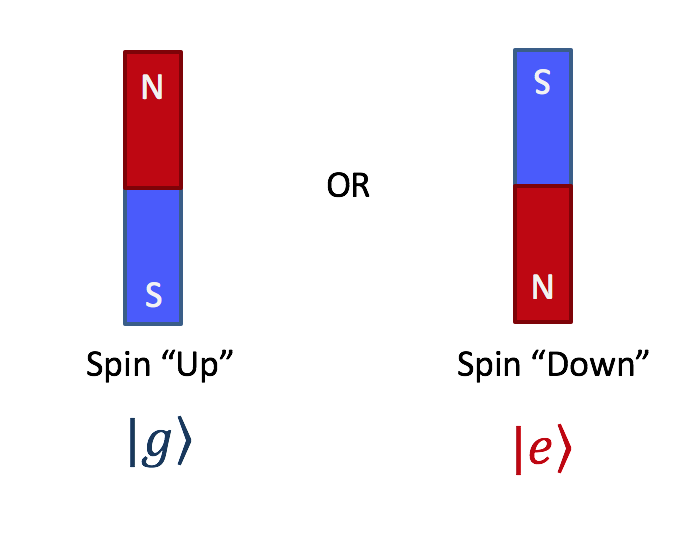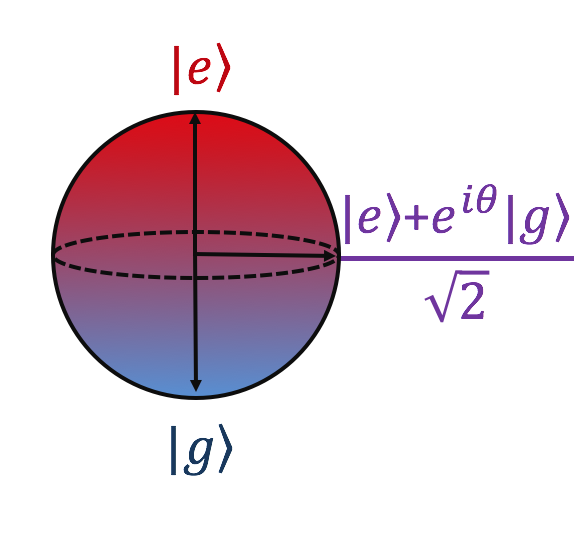The first and most fundamental building block of a Quantum Computer are the bits themselves. Naturally, we call these quantum bits "qubits". For a classical bit, you can picture two discrete energy states, for instance, a bar magnet aligned in an electric field like so:
But for a qubit on the other hand, the two discrete states still exist, but we typically picture the object now as a 3D sphere (the Bloch sphere), since quantum objects can exist in superpositions of both states at once! The vector from the center indicates the current state.
Like I mentioned briefly, there are multiple ways to build qubits, because there are many ways we can construct quantum states with 2 energy levels. In the superconducting platform, we build qubits out of collective electrodynamic excitations in extremely tiny circuits.
Even within the superconducting umbrella itself, there are many ways to make a qubit! HOWEVER, certainly the most famous variety is the ~transmon~!
The transmon arose from the circuit we refer to as the "Cooper Pair Box," (CPB) first described theoretically by Büttiker and realized experimentally by the Saclay group in 1997. The CBP consists of a thin superconducting strip of metal connected via Josephson Junctions to bulk.
The quantum dynamics, or Rabi Oscillations, between the two energy levels, the ground and excited state, were first measured in 1999 by Nakamura and his group at NEC ( https://arxiv.org/pdf/cond-mat/9904003.pdf).
This result was HUGE!! Even though back ~20 years ago the lifetime due to decoherence of these devices were only on the order of a few nanoseconds! Now with this mode of control, the stage has been set for the entrance of the transmon...
I'm going to pause for a sec here, since (1) I want to build up some excitement/anticipation and (2) it is lunchtime and I am starving  stay tuned!
stay tuned!
 stay tuned!
stay tuned!
OK I AM BACK. SO. The ~transmon~ qubit was invented at Yale in 2007 by three of the biggest names in the field: Devoret, Schoelkopf, and Girvin, along with many graduate students and postdocs! ( https://arxiv.org/pdf/cond-mat/0703002.pdf)
The transmon is very similar to the CPB in terms of design, however, it features a very specific ratio of the Josephson energy to the charging energy (EJ /EC) which DRASTICALLY reduced its' sensitivity to charge noise, thereby making the qubit much longer lived.
But what do I even mean by "longer lived"? when talking about qubits, we generally refer to 2 different coherence times, T1 and T2. T1 measures the rate of spontaneous relaxation from the excited state to the ground state, while T2 measures the rate of dephasing. Longer = better!
When we want to measure a trasmon, we actually never interact with the qubit directly. We actually put the qubit in a superconducting 3D cavity (à la @HanheePaik) or couple it to a 2D resonator.
The state of the qubit will actually CHANGE the resonant frequency of the cavity, which means by measuring the resonator, we can deduce the qubit's state  .
.
 .
.
It has been 20 (!) years since the invention of the superconducting qubit and performance of these devices has improved tremendously! Just this year, T1 times have been reported to exceed 300 us!! https://arxiv.org/pdf/2003.00024.pdf
But perhaps the coolest part for me at least, is the fact that you don't need to be working in a lab anymore to measure a qubit. Ready to measure your own qubit from the comfort of your couch/bed/anywhere you please? You can on the IBM quantum experience! https://qiskit.org/textbook/ch-quantum-hardware/calibrating-qubits-openpulse.html#A.-Calibrating-$%5Cpi$-pulses-using-a-Rabi-experiment-

 Read on Twitter
Read on Twitter



